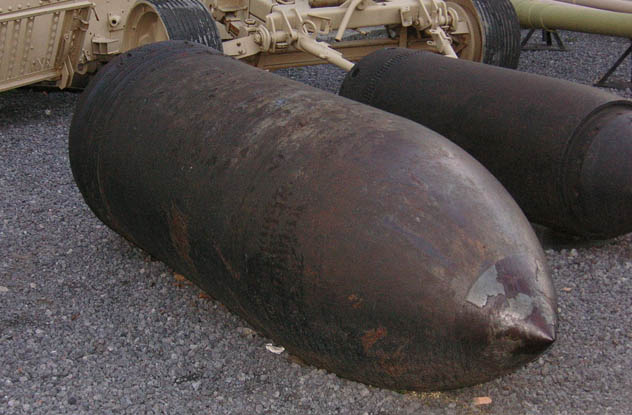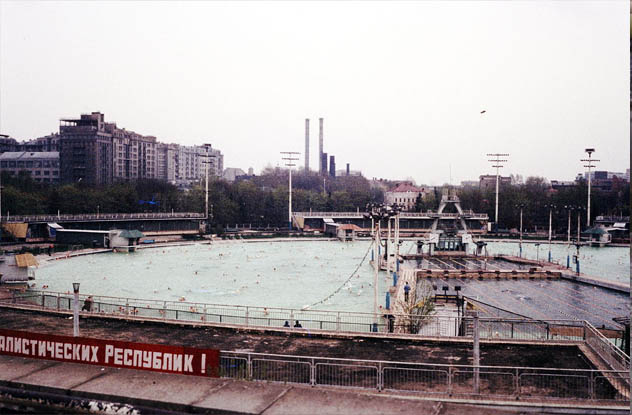 Movies and TV
Movies and TV  Movies and TV
Movies and TV  History
History 10 Things You Never Knew About Presidential First Ladies
 Movies and TV
Movies and TV 10 Zombie Movies That Will Actually Terrify You
 Humans
Humans 10 Times Scientists Were Absolutely Sure… and Absolutely Wrong
 Our World
Our World 10 Pivotal Moments for Life on Earth
 Movies and TV
Movies and TV 10 Most Realistic Medical TV Shows of All Time
 Creepy
Creepy 10 Eerie & Mysterious Ghosts of the Pacific Coast
 Weird Stuff
Weird Stuff 10 Typos That Accidentally Changed History
 History
History 10 Times Trickery Won Battles
 Technology
Technology 10 Awesome Upgrades to Common Household Items
 Movies and TV
Movies and TV 10 Movie Flops That Found Their Way to Cult Classic Status
 History
History 10 Things You Never Knew About Presidential First Ladies
 Movies and TV
Movies and TV 10 Zombie Movies That Will Actually Terrify You
Who's Behind Listverse?

Jamie Frater
Head Editor
Jamie founded Listverse due to an insatiable desire to share fascinating, obscure, and bizarre facts. He has been a guest speaker on numerous national radio and television stations and is a five time published author.
More About Us Humans
Humans 10 Times Scientists Were Absolutely Sure… and Absolutely Wrong
 Our World
Our World 10 Pivotal Moments for Life on Earth
 Movies and TV
Movies and TV 10 Most Realistic Medical TV Shows of All Time
 Creepy
Creepy 10 Eerie & Mysterious Ghosts of the Pacific Coast
 Weird Stuff
Weird Stuff 10 Typos That Accidentally Changed History
 History
History 10 Times Trickery Won Battles
 Technology
Technology 10 Awesome Upgrades to Common Household Items
10 Massive Things We Built And Then Destroyed
When the first modern human built the first permanent structure, it was fated that a rival would not rest until he had erected a larger one. We love big things, we’re fascinated with huge things, and we’re left in awe of massive things. But sometimes even the most massive of man-made objects becomes lost to time because of disaster or necessity.
10The Great Wheel

Sure mankind loves big things, but we also love fun. We also happen to love money, and every once in a while, nostalgic childlike playfulness and the drive for money combine to create the colorful and often sticky environments known as carnivals. Carnivals and fairs are excellent venues for temporary structures large and small because the venues themselves are, of course, temporary.
The grandest of all fairs in the world are the aptly named World’s Fairs; the Eiffel Tower was constructed specifically for the 1889 World’s Fair in Paris. Fast-forward to the 1893 World’s Fair in Chicago, and fair officials realized that their venue needed their own answer to the Eiffel tower. The Ferris Wheel was born.
While the Ferris Wheel might seem commonplace in today’s world of advanced engineering, the competition to build the largest Ferris Wheel still remains heated. Today, the London Eye stands as a testament to this ideology as a past holder of this prestigious title, but that wasn’t the capital city’s first attempt. The Great Wheel was the world’s tallest Ferris Wheel for a period of five years from 1895 to 1900.
Built for the Empire of India exhibition, it stood a mammoth 94 meters (308 ft) tall and could carry 40 passengers in a single car (it also had 40 cars). Riding the Great Wheel took 20 minutes for a full revolution.
The wheel carried an estimated half a million passengers in its lifetime before being disassembled for financial reasons in 1907 by the very engineers who built it. No matter how fun something may be, it’s not fun when you’re losing money on it.
The tallest, the widest, and the absurdly enormous—watch every fascinating moment of National Geographic’s Mega Structures at Amazon.com!
9SS Great Eastern

Though the SS Great Eastern didn’t have a wheel quite the size of London’s, its paddle wheel was probably large enough to double as a Ferris wheel at most local fairs. Yet it still managed to look relatively small on this awe-inspiringly huge oceangoing vessel.
The massive steamship the Great Eastern was born from the sketches of the brilliantly named Englishman Isambard Kingdom Brunel and was brought to life in 1858. When it was launched, the Great Eastern was so big it was initially christened Leviathan. She was a staggering six times larger than any existing naval vessel at the time, and her reign as largest in the world at just about 210 meters (700 ft) wasn’t bested for another four decades.
The ship required three months to get afloat and bankrupted the company that originally owned it. Further problems followed; a boiler explosion hindered her first voyage and bankrupted her second owners in 1859, and in 1862, she struck an uncharted rock in New York Harbor, bankrupting yet another company as a result.
The massive vessel relinquished her passenger duties and took up the vital task of linking continents via trans-Atlantic telegraph cables from 1866 to 1874. But despite her valiant efforts, she was scrapped in 1888 after spending her final years as a floating billboard in Milford Haven, Wales. When her skin was removed during scrapping, it was rumored that a human skeleton was found trapped within her double hull and that the ship’s misfortunes were a result of a curse. While this is most likely an urban legend, it would explain why the SS Great Eastern never found the glory that she deserved in her troubled lifetime.
8Tsar Tank

The intriguing events that led to the Tsar Tank began in 1914, when Russian engineer Nikolai Lebedenko dreamed up a tank with 8-meter (27 ft) diameter wheels that could clear almost any obstacle imaginable. Nicholas II enthusiastically funded the project. The story goes that Lebedenko demonstrated the tank to the Tsar himself with a small wooden model traversing stacked books, instantly convincing Nicholas II.
In 1915, during a maiden test in front of high-ranking military officials, the mighty obstacle that brought down the hulking Tsar Tank was nothing more than a simple mixture of earth and water, known commonly as “mud.” Lebedenko was determined to rectify the problem by adding bigger engines to the chassis, but the fate of the Tsar Tank was sealed. It was simply too expensive to develop any further, and the only example of this strange and mighty tank sat bogged down in the mud all throughout World War I until 1923 when it was ultimately scrapped. No matter how grand your ideas might be, first impressions truly are everything.
If you think that tank looks ridiculous, wait until you hear about some of the other ludicrous weapons in the history of warfare. From living cow bombs to Bohemian Ear Spoons, no stone is left unturned in Midget Ninja and Tactical Laxatives: Bizarre Warfare Through the Ages at Amazon.com!
7The Crystal Palace

The World’s Fairs produce some incredible works of architecture and engineering, so it should come as no surprise that when London held the Great Exhibition of 1851 it commissioned its own modern marvel. Sir Joseph Paxton designed a 23-acre building composed largely of glass panels and steel framing known as the Crystal Place.
The structure was unique at the time as it was a modular system of common elements that came together to form a larger work. Boasting 90,000 square meters (990,000 sq ft) of floor space, a length of 563 meters (1,848 ft), and an overall roof height of over 30 meters (100 ft), the Crystal Palace was something only a World’s Fair could justify. The building housed so many exhibits that over 13 kilometers (8 mi) of display tables were needed to house them all.
Such an enormous building proved difficult to swallow once the fair ended. Regardless of the monumental scale of both the structure and the operation needed to move it, the Crystal Palace was relocated to the affluent Sydenham Hill region of London in 1854. There, it served as a venue for sporting events, plays, museums, and other exhibitions until its destruction in a fire in 1936. The remaining water towers of the structure were demolished in 1941 for fear of being used as a landmark by German bombers in World War II. Today, any remnant of the Crystal Palace only exists in the pages of history.
6Big Muskie

Mining operations are well known for using machines large enough to classify as small municipalities. Internet readers and bloggers are fascinated with vehicles such as the massive excavator Bagger 288, which is so big and so outlandish that most people dismiss it as photo manipulation upon first glance.
Machines of staggering size are often built to maximize efficiency. How else could you justify Big Muskie, a machine nearly 22 stories tall with a bucket that weighed 200,000 kilograms (460,000 lb) dry? Serving as a vital role in strip-mining, in which earth is dug out to uncover layers of coal, Big Muskie ripped out 4.8 million cubic yards of dirt in its 22 years of service.
Big Muskie didn’t move via treads or wheels. Rather, it had huge hydraulic feet that shuffled the beast from location to location, often taking days to move a mere mile. In the end, Big Muskie was just too big and costly to operate. A drastic drop in demand for high-sulfur brown coal rendered a machine as wide as an eight-lane highway unnecessary and unprofitable.
Even after disassembly, Big Muskie is the largest bucket-digging machine ever built. The only thing that remains of Big Muskie today is its mammoth bucket which manages to draw thousands of roadside tourists every year.
5Schwerer Gustav

Few circumstances bring about massive engineering feats quite like war. The Schwerer Gustav came about because of Adolf Hitler’s distinct dislike of France and their seemingly impenetrable fortifications along the German frontier in 1941. The only solution to this problem was a railway-transported gun with projectiles so large that each round had to be slightly wider than the last due the shock wave expanding the barrel’s lining.
The four-story gun fired 4,500-kilogram (10,000 lb) explosive rounds 50 kilometers (30 mi) in a mere 170 seconds. And the Nazis built two of them. But the Schwerer Gustav and its sister gun the Dora were far too big for their own good. It took a crew of 500 men under the command of a Major General to efficiently move one and accurately aim its 30-meter (100 ft) barrel.
When the war ended, the impractical Schwerer Gustav was seized and scrapped by American troops. Dora was deliberately destroyed to avoid enemy capture in 1945.
4Moskva Pool

In 1931, the Soviet Union wanted to build a grand building called the Palace of the Soviets in Moscow. Though the first competition to choose its design ended without a winner, a second public competition drew in over 272 different concepts by 160 architects around the world. After turning down famous names such as Le Corbusier and Walter Gropius, the judges chose Boris Iofan and his neoclassical design consisting of a 415-meter (1,362 ft) skyscraper topped with a statue of Vladimir Lenin so big it could keep the Statue of Liberty as a pet.
The Palace of the Soviets was also to include a centralized main hall with seating for over 20,000 people as well as a library inside Lenin’s head. If it was completed, this grand ambassador of communism would have been the world’s tallest building, easily eclipsing the Empire State building by around 100 feet. But it was never to be, as the Nazis invaded Soviet Russia in 1941, forcing construction on the palace to halt and the existing material to be repurposed elsewhere for infrastructure.
In 1958, the Soviets filled the building’s foundations with water, making the world’s largest open-air swimming pool. The Moskva swimming pool remained open all year round for the next three decades before being destroyed for yet another foundation in 1995 for the Cathedral of Christ the Savior. This church happened to be an exact replica of the church original demolished to make way for the failed Palace of the Soviets.
3The Great Hedge Of India

You might be scratching your head on how a hedge can justify an identifier such as “great,” but that moniker becomes appropriate when you learn that the hedge in question was a staggering 2,400 kilometers (1,500 mi) long and required 12,000–14,000 men to maintain it. It also managed to be 2–4 meters (6–12 ft) thick and 3–4 meters (10–14 ft) high, but its real strength was its length, which was very nearly enough to split India in half longitudinally.
The Great Hedge was a product of humanity’s insatiable demand for salt. In the 1800s, the British East India Company had a stranglehold on the salt trade in India. But because salt is so easily accessible from the ocean, India’s entire coastline became a free-for-all for anyone wishing to smuggle the precious mineral substance. The hedge became a barrier at presumably great cost and questionable effectiveness.
In 1879, the tax laws changed, smuggling ceased, and the hedge was no longer necessary. It was dismantled and swept under the rug in Western history as an unflattering example of British foreign policy. It became all but lost to history until 1995 when British librarian Roy Moxham discovered obscure references to the mighty plant. Further expeditions headed by Moxham himself to find remains of the hedge came up positive. In 1998, a small raised embankment was identified as the possible sole last remains of the once Great Hedge of India.
2London Underground Aircraft Factory

During the Blitz in the 1940s, Great Britain found itself in a predicament, wondering how to build its military while Germany continually bombed all visible defense sites. The answer happened to lie below the ground because not even Germany’s mightiest of bombs could penetrate an average depth of 24 meters (80 ft) of earth. How convenient then that London happened to possess a unique resource in the London Underground, which had nearly 160 kilometers (100 mi) of underground tunnels.
The subterranean British war effort focused on getting aircraft component manufacturer Plessey back on its feet after having its factory leveled by German bombers in 1940. By 1942, Plessey employed 4,000 workers on 30,000 square meters (300,000 sq ft) of factory floor space protected by the Earth itself. For four years, a predominately female workforce numbering in the thousands worked long hours in the often stifling conditions associated with what was most likely the world’s narrowest factory ever built.
As the war came to a close, the London Underground quickly reverted to its primary duties of civilian transport. Today, there exists virtually no indication of the wartime factory that once was the proud if not claustrophobic effort of thousands of British civilians.
1Seawise Giant

The Seawise Giant was a product of the late 1970s when supertankers were being constructed in shipyards all over the world to meet the demand for crude oil. After she admirably bankrupted her original Greek owners while still under construction, the Giant was acquired by a Hong Kong shipping magnate who looked at her monstrous dimensions, remarked that it wasn’t quite big enough, and further increased her size to its dizzying final form.
The Seawise Giant was so gargantuan that her length was measured in skyscrapers and her deck area measured in soccer fields. At 450 meters (1,500 ft) with a width of 69 meters (225 ft), she was so large that she couldn’t pass through the English Channel and was so heavy that she took 9 kilometers (5.5 mi) to come to a complete stop.
Her immense size most likely saved her in 1988 when she was attacked by Iraqi fighter jets during the Iran-Iraq war while traveling through the Straits of Hormuz. She remained easily accessible for salvage in the shallow waters in which she partially sank. After being resurrected in 1989, she continued service under a litany of different names until 2004, when she was moored as a permanent offshore loading and storage platform in the Persian Gulf. The Knock Nevis, as she was renamed, would never see the open ocean again. In 2009, like many other commercial naval vessels, she was sold to be scrapped in Alang, India.
The only thing that remains of the world’s largest ship is her 36-ton anchor, which now resides in front of the Hong Kong Maritime Museum.
Patrick studies Industrial Design at the University of Illinois at Chicago. He is fascinated with big things and often spends far too much time researching tall buildings and large ships rather than focusing on more fruitful ventures such as Facebook and Twitter.








